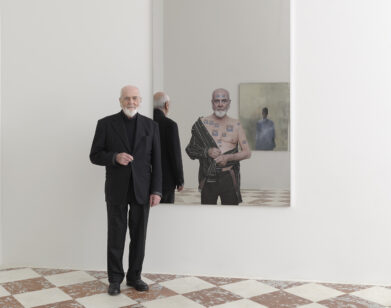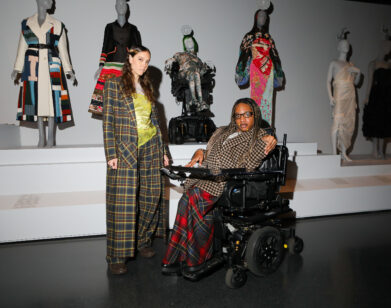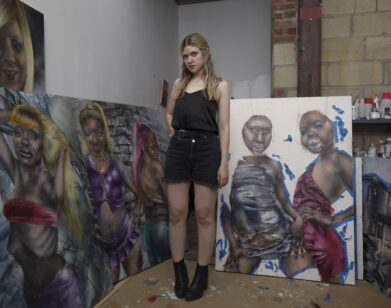The Artist Bunny Rogers is Making the Macabre Optimistic

Photo by Diana Pfammatter.
“I feel like I have a soul now,” Bunny Rogers said on the phone from Frankfurt, days after the opening of her exhibition Pectus Excavatum at the Museum für Moderne Kunst. Following her 2017 Whitney solo exhibition Brig Und Ladder, which served to complete a trilogy of installations about the Columbine High School massacre, the American-born artist retreated into a year-long hermitage. It was during this time that she revisited a number of childhood fixations, some of which manifest in her latest exhibition: a fluorescent giant squid beached in the center of a massive room; an iron-rod fence with grosgrain ribbons tied to it. The latter, an allusion to fairytale decapitation, rings especially eerie considering Rogers is often seen with ribbons in her hair. The habit is an example of the 29-year-old’s ability to pull apart the symbolism of death, and in turn, make it less shocking. Like the mythological sea creatures that populate Roger’s imagination, gruesomeness is often so shrouded in sensationalism that it loses its outline. Yet in her work, the macabre takes on a type of optimistic monumentality.
———
ZOMA CRUM-TESFA: This show is coming off the completion of the Columbine Trilogy. How did it feel to complete that work?
BUNNY ROGERS: Creatively speaking, it was really hard. When you’re building up to a show, you feel like a fraud when you’re not working, and when you are working – I mean, exhausted is putting it lightly. Yet, the day after the show opens you already feel fraudulent again. So after the trilogy, I took a year being a hermit and stayed kind of outside the process. I now feel like I’m in a healthier place than I was maybe five years ago or something. I can actually say that I have a spirituality.
CRUM-TESFA: What do you mean by that?
ROGERS: A big step for me was treating my physical body better, and not abusing it. That was such a big step into entertaining the possibility that my spiritual self had any worth. I feel like I have a soul now, and for a long time I tried to block that out, because my thoughts would just run wild and I would get overwhelmed by them.
CRUM-TESFA: Totally.
ROGERS: I think one of the smartest things you can own up to as a person is admitting that you aren’t certain about anything, that you don’t know anything for certain. My personal experience is kind of all I have to go by, but admitting that you don’t know anything is also kind of freeing in a way. I feel the idea definitely brought me back in touch with feelings I had when I was a child, where I felt so sensitive and intuitive, and connected with animals.
CRUM-TESFA: What kinds of animals?
ROGERS: I’ve always had an interest in deep sea creatures. I love the stories of sea monsters and ocean lore, the mythology of the sea and ocean.
CRUM-TESFA: Which sea monsters fascinated you most?
ROGERS: The classic ones, where the creature is depicted taking down a ship or anything with a plesiosaur —
CRUM-TESFA: Plesiosaur?
ROGERS: Nessie, the Loch Ness Monster of Loch Ness, is a plesiosaur. And Champy, from Lake Champlain, has had similar classifications, although some consider it more snake-like. And there are many variations of them throughout different cultures and, at times, human history. I love the hydra, for instance, the eight-headed serpent monster. Water dragons and sea snakes could also be considered related.
CRUM-TESFA: And not mermaids?
ROGERS: No. I find the humanoid aspect a turn-off.
CRUM-TESFA: Why the water?
ROGERS: I’m not sure why. Maybe it’s because swimming was important in my family. Or maybe it’s that, where some kids are connected to outer space and the aliens there, I saw the ocean as an alien world. There are so many accounts by ship hands from another era describing the ocean’s surface as rolling with life, and during certain eras there were more of these accounts. In 1910, for example, lobsters were taking over the East Coast, and there were, by some accounts, populations of lobsters that were six-feet long. We still find the occasional four-foot lobster. That says to me that even a short while ago, something that may now be unimaginable could have easily existed — especially in the ocean. We still haven’t explored nearly 85 percent of it.
CRUM-TESFA: Tell me about the about the fence sculpture with ribbons on it.
ROGERS: There have been lots of obituaries of tragic deaths where people fell from mansion windows and would be killed on an iron-rod fence. There’s also a popular scary story, of the girl with the green ribbon, where when you pull her scarf off, her head rolls. So this girl kind of haunts this fence. I’ve often asked what is generally more disturbing to people: decapitation or getting cut in half? I have a hard time answering. I’ve asked people that question and I’ve gotten mixed answers. I generally think that decapitation is on a base level more disturbing, because we project so much onto the head and the face and the brain for meaning. I read a lot of true crime, and one of the most striking murders I can remember is that kidnapped girl –
CRUM-TESFA: Sharon Tate?
ROGERS: The Black Dahlia.
CRUM-TESFA: Oh, Black Dahlia.
ROGERS: Her name was Elizabeth Short – yes, and she was an aspiring starlet in the 40s, and was murdered. She was cut in half.
CRUM-TESFA: Oh my gosh.
ROGER: And the creepy thing was that she was drained of almost all her blood. I’m almost positive that was the inspiration for that season of Dexter.
CRUM-TESFA: For me, decapitation is preferred. It wouldn’t scare me.
ROGERS: I actually just had this conversation with someone today, where I said I’d rather get decapitated.
CRUM-TESFA: Right, because the whole point is that you’re definitely dead. In your other work, you’ve had your hair in ribbons. Had you been aware of that story of the decapitated girl back then?
ROGERS: When I was a kid, I was obsessive about that story. I wonder why. Maybe I’m in the decapitation camp, and I don’t realize it. I collect ribbons. I also collect wools. There’s just something so satisfying about loomed fiber that is wholly intact, and you just admire it for the beautiful piece of fabric that it is. There is a history of ribbons being used as decoration beyond how we know them, like in your hair or on your neck. The first portrait for Columbine Library is a girl with a green ribbon. It is Joan of Arc with the green ribbon holding the Elliott Smith plushie. I guess I do really enjoy mythology, but I don’t think of the paranormal as an umbrella — “Oh, this is exciting and creepy.” There’s been enough death in my family that it’s no longer just scary. It’s more complicated than that, and death is more interesting as a result.
CRUM-TESFA: Do you think these plushies and perfumes and ribbons give a kind of slow glow to your artwork that subverts these very intense narratives?
ROGERS: I think there’s a desire in there — “I want to see this as a plush toy.” Or, “I literally want to make fan merchandise for Elliott Smith.” I haven’t thought enough about what those softer things mean actually. There are a lot of harsh pieces, like the computer chair with shotgun holes. Even the 3D renders have a sharp look to them.
CRUM-TESFA: I guess it’s often difficult in a complex project to know what you’re doing as you’re doing it.
ROGERS: I do think there’s an important point in there. When things are put through a meat grinder, then you don’t know what the hell you’re looking at at the end of the process. Recently, someone said to me that my artwork looked “just dated.” It was really interesting to me, because they were younger than me, so of course it’s going to look dated to them. But it became apparent to me that my subject matter is now moving on and becoming aged. And that’s okay. To me, my work is never going to feel dated because these things are always bubbling up for me and are still just as fresh as they were when I consumed them.






